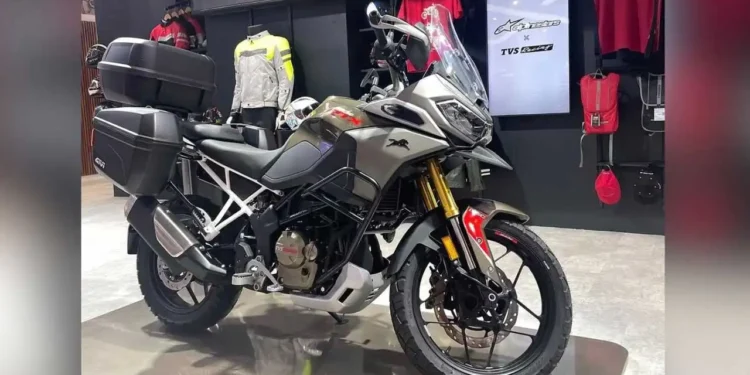TVS Apache RTX 300 ADV Launch October 15 : Quick Take
- Launch Date: October 15, 2025
- Price Band: ₹2.2–2.5 lakh ex-showroom
- Positioning: Mid-segment ADV built for daily commutes and weekend touring
- Key Rivals: Hero Xpulse 200, Royal Enfield Himalayan 450, KTM 390 Adventure
- Strategic Play: Apache performance DNA + TVS’s nationwide reach, priced below premium 390 territory
Specifications unconfirmed until launch.
The News
TVS is entering India’s adventure-touring segment with the Apache RTX 300 ADV, targeting the sweet spot between entry-level 200cc ADVs and the tech-heavy, pricier 390 class. The brief is clear: upright ergonomics for the weekday grind, genuine touring comfort for long weekends, and bad-road composure—without the cost or complexity of bigger ADVs.
Expected Specifications
Engine & Performance
- ~300cc liquid-cooled single, 6-speed
- Output: ~35 hp / 28–29 Nm, tuned for a strong mid-range
- Kerb Weight: under 180 kg target for friendly city manners and light-trail control
Chassis & Suspension
- Frame: evolved Apache architecture, reinforced for luggage and stability
- Suspension: long-travel USD fork + preload-adjustable monoshock
- Travel (class-typical): ~170–190 mm front, ~170 mm rear
- Wheels/Tyres: 19/17-inch combo (alloys initially; spokes likely as a variant)
- Ground Clearance: ~200–220 mm
- Brakes: dual-channel ABS with off-road logic / rear-ABS defeat
Electronics & Features
- Ride modes, slipper/assist clutch
- TFT display with Bluetooth, turn-by-turn navigation
- LED lighting, USB-C charging, adjustable windscreen, hand guards (variant-dependent)
Practical Bits
- Fuel Tank: 13–15 L touring range
- Seat Height: ~820–840 mm for average Indian riders
- Real-World Efficiency: 28–35 km/l depending on load and pace
- Service Intervals: early checks at 1k/5k km, then every 5–6k km
- Warranty: 2–3 years standard with paid extensions
- On-Road (metros): ₹2.7–2.85 lakh for a ₹2.3 lakh ex-showroom point
Why This Launch Matters
Adventure-touring is the fastest-growing enthusiast category in India. The Himalayan 450 has shown sustained demand under ₹3 lakh, the Xpulse 200 dominates value, and the KTM 390 Adventure sets the premium benchmark. The Apache badge brings immediate credibility for step-up riders moving from 125–200cc machines. Priced at ₹2.2–2.5 lakh, the RTX 300 promises far more capability than 200-class ADVs while staying simpler and cheaper to own than the 390 class.
There’s also a strong export angle. TVS’s sizeable overseas footprint gives a 300cc ADV room to scale in markets like ASEAN, LATAM and Africa, where rugged, fuel-efficient tourers sell briskly. Cross-market volume can help keep India pricing sharp.
Competitive Landscape
Quick Comparison
| Model | Engine | Power | Price (ex-showroom) | Positioning |
|---|---|---|---|---|
| Hero Xpulse 200 | 200cc single | ~18 hp | ₹1.4L | Entry ADV, light trail, high value |
| TVS Apache RTX 300 (expected) | ~300cc single | ~35 hp | ₹2.2–2.5L | Mid-segment, balanced performance & comfort |
| RE Himalayan 450 | 452cc single | ~40 hp | ₹2.85L | Long-haul capability, brand heat |
| KTM 390 Adventure | 373cc single | ~43 hp | ₹3.3L | Premium tech/performance benchmark |
Trade-offs
- Vs Xpulse 200: big upgrade in highway stability, power and range; higher upfront price and insurance.
- Vs Himalayan 450: likely lighter and nimbler in the city; gives up some extreme off-road prowess.
- Vs KTM 390 ADV: more affordable and simpler to own; less outright output and fewer top-tier electronics.
TVS strengths: Apache performance tuning, proven reliability, strong features-to-price equation, 5,000+ touchpoints nationwide.
Challenges: Royal Enfield’s brand heat, KTM’s spec advantage, late entry into a noisy category.
Market Opportunity
The RTX 300 ADV is a smart portfolio extension. TVS deepens its premium ladder beyond commuters and scooters, complementing RTR/RR lines with a touring-first product. Manufacturing synergies with Apache platforms aid cost control and speed-to-market. For dealers, this is a higher-margin model than volume scooters—expect strong push in metros and touring-centric tier-2s.
Buyer reality: a bike that’s comfortable at 90–110 km/h, shrugs off broken tarmac, and isn’t intimidating to live with. A 300cc single hits the brief—adequate highway punch, friendly urban manners, and insurance/registration costs that stay below 400+cc bands.
Pull Quote
“The Apache RTX 300 doesn’t need to kill the Himalayan or out-tech the KTM to win. It must feel lighter than the Himalayan in the city, more planted than 200-class bikes on the highway, and deliver far better value than a 390.”
What to Watch
Launch-Day Checklist
- Price: the make-or-break—₹2.2–2.4L is the bullseye
- Real-world specs: suspension travel, ground clearance, steering lock, seat height, tank size
- Electronics polish: ride-mode logic, off-road ABS tuning, clean TFT UX
- Variants & colors: alloy vs spoke, touring kits, crash protection
- Deliveries & offers: intro pricing, finance/insurance bundles, accessory packs
Post-Launch Signals
- Bookings: the first 72 hours show supply vs demand
- Dealer feedback: test-ride queues, luggage/screen/guard uptake
- Reviews: heat management, economy, suspension tune on poor surfaces
- Success benchmark: 1,000+ units/month is a strong start; for context, Himalayan 450 often runs ~4,000–5,000/month, Xpulse 200 ~2,500–3,000/month. Even 1,000 puts RTX 300 among TVS’s top revenue drivers after Jupiter and Apache street models.
The Bottom Line
TVS rarely swings without a plan. The Apache RTX 300 ADV targets the largest underserved slice of the market: riders who want genuine touring comfort and rough-road headroom without 390-class pricing or big-ADV heft. The Apache badge supplies performance credibility; TVS’s service footprint underwrites ownership confidence. If pricing lands in the target window and the hardware delivers on real-world touring, the RTX 300 is well placed to become the dark horse many riders actually buy.










